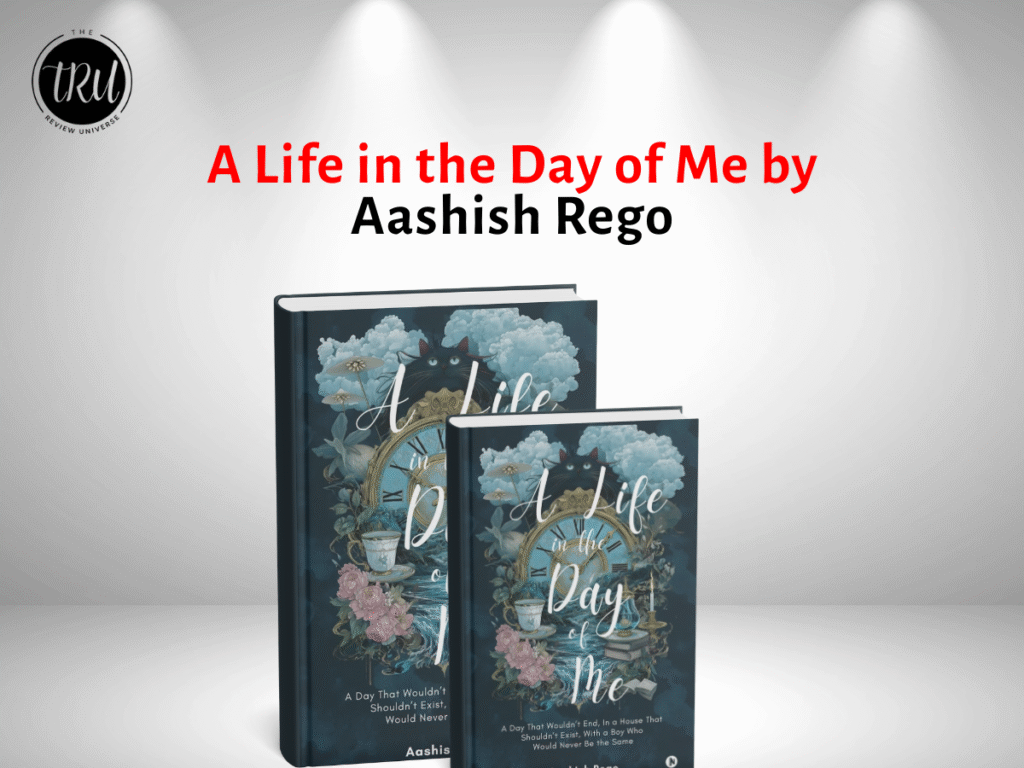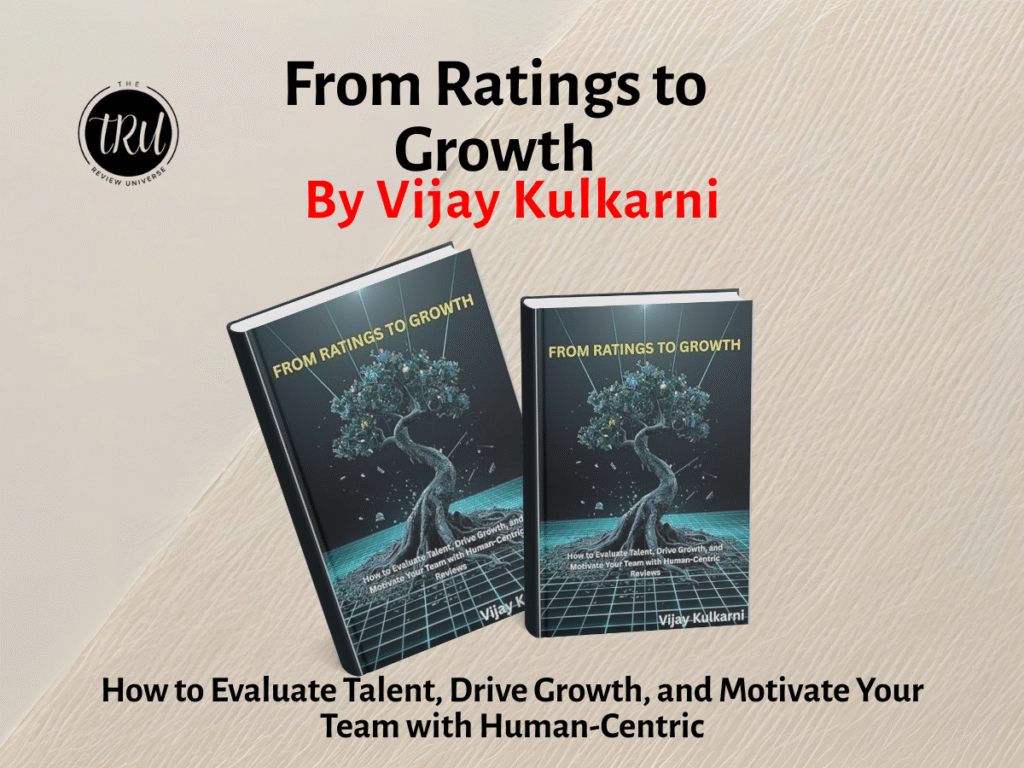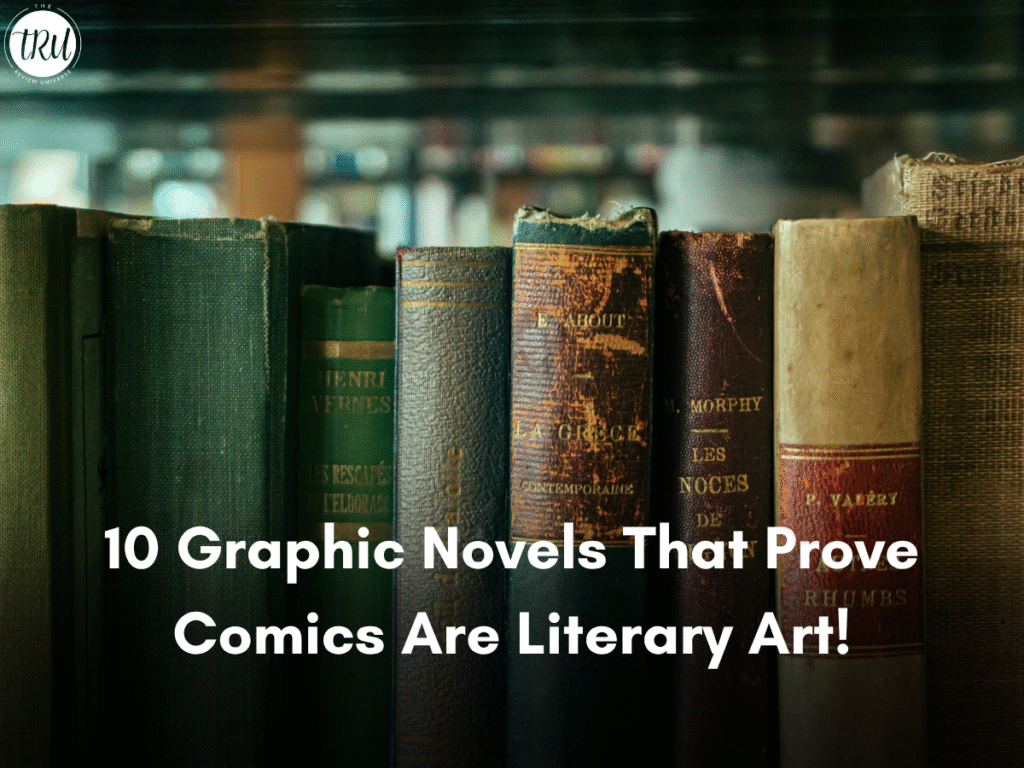
Explore 10 literary graphic novels that blend art and storytelling to tackle themes like identity, trauma, love, and resilience across cultures and genres.
Graphic novels showcase the versatility of the medium, demonstrating how comics can handle sophisticated themes, nuanced characters, and deep emotional and philosophical explorations. Graphic novels are increasingly recognized as a powerful literary form that combines visual art with complex storytelling. Graphic novels prove comics are more than just entertainment—they are a medium for exploring deep themes, characters, and intricate narratives, making them works of literary art.
Graphic novels are an increasingly respected form of literary expressions that merge visual art with storytelling to create a medium capable of exploring complex themes, intricate narratives, and profound human experiences. Far from being mere entertainment, graphic novels offer nuanced perspectives on issues such as identity, history, trauma, and the human condition.
Works like Maus by Art Spiegelman, which depicts the horrors of the Holocaust through the lens of a father-son relationship, and Persepolis by Marjane Satrapi, an autobiographical account of growing up in post-revolutionary Iran, illustrate how comics can convey powerful social commentary and deep emotional resonance. Additionally, graphic novels like Watchmen by Alan Moore and The Sandman by Neil Gaiman deconstruct genre conventions, blending philosophical inquiry with intricate plots to challenge traditional notions of heroism, morality, and existence.
Graphic novels combine visual storytelling with literary narrative, making them a unique medium where illustration and text work together to create immersive experiences.
1. Visual Storytelling
Graphic novels use sequential art—panels, composition, color, line work, and layout—to tell a story. The visual elements are just as important as the text, often conveying mood, tone, and emotion in ways that pure prose cannot.
2. Artistic Styles
The art in graphic novels spans a wide range of styles—from highly detailed realism (like in Maus by Art Spiegelman) to abstract or minimalistic (like in Blankets by Craig Thompson). The style chosen often complements the story’s themes and emotional impact.
3. Cultural and Social Commentary
Many graphic novels tackle serious social, political, or personal issues, using art to deepen the impact. Works like Persepolis by Marjane Satrapi or Fun Home by Alison Bechdel use graphic storytelling to explore identity, history, and trauma.
4. Innovative Use of the Medium
Artists experiment with panel layouts, color palettes, and page design to challenge conventional reading patterns, creating dynamic pacing and emphasizing key moments visually.
5. Recognition as a Legitimate Art Form
Graphic novels have increasingly gained recognition in the literary and art worlds. Museums, galleries, and academic institutions now study and exhibit graphic novels, acknowledging their artistic and cultural significance.
The visual medium of graphic novels allows for a unique synthesis of words and images, enhancing storytelling through visual metaphors, symbolism, and pacing in ways that traditional prose cannot. With works like Fun Home by Alison Bechdel, Daytripper by Fabio Moon and Gabriel Ba, and Blankets by Craig Thompson, graphic novels have demonstrated an ability to engage with themes of family, love, loss, and self-discovery, pushing the boundaries of what is possible within both literature and visual art. Through their rich artistry and emotional depth, graphic novels have firmly established themselves as a legitimate and powerful form of literary art.
- Maus: A Survivor’s Tale by Art Spiegelman
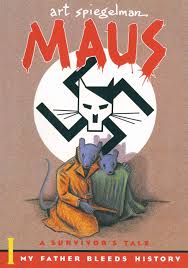
It is often cited as the graphic novel that changed the perception of the medium. It tells the story of the Holocaust through the lens of a son interviewing his father, a survivor of Auschwitz. The use of animals as characters (Jews are portrayed as mice, Nazis as cats) adds to its complexity and depth, blending historical events with personal trauma in a unique way.
Maus: A Survivor’s Tale by Art Spiegelman intertwines the past and present as the author interviews his father, Vladek, a Jewish survivor of the Holocaust. The story shifts between Vladek’s harrowing experiences during World War II and his strained relationship with Art in modern-day New York. Vladek recounts life in pre-war Poland, his marriage to Anja, and the increasing persecution of Jews.
As the Nazis rise to power, Vladek and Anja go into hiding but are eventually captured and sent to Auschwitz. In the camps, Vladek uses his resourcefulness to survive the brutal conditions. The narrative reveals the trauma carried by survivors and the emotional toll on their families. Art struggles with understanding his father’s pain and coping with the suicide of his mother, Anja. The comic portrays Jews as mice, Nazis as cats, and Poles as pigs, using animal allegory to convey complex human realities. Vladek’s meticulous storytelling reveals both his survival tactics and personal flaws. In the end, Art comes to terms with his father’s past, preserving his story while grappling with its emotional weight.
- Persepolis by Marjane Satrapi

Persepolis is an autobiographical graphic novel that explores the author’s childhood in Iran during and after the Islamic Revolution. Through its stark, minimalist black-and-white art, Satrapi delivers a poignant, often humorous narrative about identity, family, and political upheaval. Its emotional depth and historical context make it a critical work of modern literature.
Persepolis by Marjane Satrapi is a graphic memoir that follows Marjane’s childhood and early adulthood during and after the Islamic Revolution in Iran. As a young girl from a progressive family, she witnesses the fall of the Shah, the rise of the Islamic regime, and the violent impacts of war. Marjane struggles with the restrictions placed on women, including wearing the veil and losing personal freedoms.
Her rebellious spirit leads her to question religion, authority, and politics. To protect her, her parents send her to Austria as a teenager, where she faces alienation, racism, and identity crises. While abroad, she grapples with loneliness, love, and the clash between cultures.
She returns to Iran, only to find the country even more repressive and herself more disconnected. Marjane tries to adjust but becomes increasingly disillusioned with life under the regime. Eventually, she decides to leave Iran permanently to reclaim her independence. The story is a powerful reflection on identity, freedom, and the cost of growing up in a time of revolution.
- Watchmen by Alan Moore and Dave Gibbons

Watchmen, deconstructs the superhero genre, blending elements of mystery, politics, and moral philosophy. Moore’s intricate storytelling and Gibbons’ detailed artwork address issues like power, corruption, and existentialism. Its non-linear narrative structure and thematic complexity elevate it beyond typical superhero fare, earning it a place as a serious work of art. Watchmen by Alan Moore and Dave Gibbons is a graphic novel set in an alternate 1985 where superheroes exist and the U.S. won the Vietnam War.
The story begins with the murder of Edward Blake, a former government-backed hero known as The Comedian, sparking an investigation by the masked vigilante Rorschach. As Rorschach reconnects with former heroes like Nite Owl, Silk Spectre, Dr. Manhattan, and Ozymandias, deeper conspiracies begin to unravel. Dr. Manhattan, a godlike being, becomes increasingly detached from humanity, while Ozymandias pursues a secret plan to “save” the world. Flashbacks reveal the dark, often morally compromised pasts of the heroes.
As nuclear tensions rise between the U.S. and the Soviet Union, Ozymandias enacts a massive deception to force global peace through fear. His plan involves faking an alien attack that kills millions in New York, uniting nations against a common enemy. The heroes are divided—some accept the sacrifice, while Rorschach refuses and is killed to keep the secret.
As nuclear tensions rise between the U.S. and the Soviet Union, Ozymandias enacts a massive deception to force global peace through fear. His plan involves faking an alien attack that kills millions in New York, uniting nations against a common enemy. The heroes are divided—some accept the sacrifice, while Rorschach refuses and is killed to keep the secret.
Dr. Manhattan departs Earth, leaving humanity to its uncertain fate. The novel ends with the possibility that the truth may still be revealed. Watchmen deconstructs the superhero myth, exploring power, morality, and the blurred line between heroism and tyranny.
- Sandman by Neil Gaiman

The novel is a multi-layered epic that blends mythology, history, and literature in a unique narrative structure. With its lush art and complex storytelling, Gaiman tackles themes of dreams, destiny, and the nature of storytelling itself. It draws on a rich tradition of literary and philosophical influences, making it one of the most sophisticated graphic novels ever created.
The Sandman by Neil Gaiman is a sprawling graphic novel series that blends mythology, fantasy, and horror, centered around Dream, also known as Morpheus or the Sandman, one of the seven Endless. The story begins when Dream is captured by a human occultist and imprisoned for decades, throwing the world of dreams into chaos.
After escaping, he reclaims his lost tools of power and begins rebuilding his realm, the Dreaming. As the series unfolds, Dream interacts with gods, demons, humans, and other Endless—Destiny, Death, Desire, Despair, Delirium, and Destruction. Each arc explores themes like change, identity, responsibility, and the power of stories.
Dream struggles with his rigid sense of duty and begins to evolve, though change comes slowly and painfully. His decisions have far-reaching consequences, including the fates of mortals and mythical beings alike. Ultimately, Dream accepts his own need for transformation, which leads to his death and the rebirth of a new Dream. The series closes with reflection, legacy, and the enduring nature of stories. The Sandman is a rich, literary tale about dreams, humanity, and the inevitability of change.
- Fun Home: A Family Tragicomic by Alison Bechdel
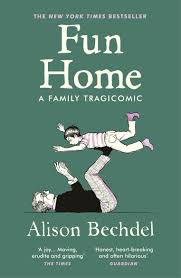
It is an introspective memoir that explores Bechdel’s coming-of-age, her relationship with her closeted father, and her own sexual identity. Bechdel’s deft use of visual metaphor, alongside her honest, layered storytelling, creates a deep narrative that’s both personal and universally relatable, blending humor, heartbreak, and intellectual insight.
Fun Home by Alison Bechdel is a graphic memoir that explores the author’s complex relationship with her father, Bruce Bechdel, a closeted gay man and funeral home director. Set against the backdrop of their family-run funeral home (the “fun home”), the narrative moves non-linearly through Alison’s childhood, adolescence, and college years. Through literary references and reflective narration, Alison examines how her father’s obsession with appearances and repression shaped their family life.
As she comes to terms with her own lesbian identity, she begins to see parallels and contrasts between herself and her father. Shortly after Alison comes out to her parents, her father dies in what she suspects may have been a suicide. The memoir delves into themes of identity, secrecy, emotional distance, and the influence of literature and art. Bechdel uses layered visuals and text to depict memory, truth, and the search for meaning. Through unraveling her father’s life, she better understands her own. Fun Home is both a coming-of-age story and a poignant meditation on family, sexuality, and self-discovery.
- Daytripper by Fábio Moon and Gabriel Bá
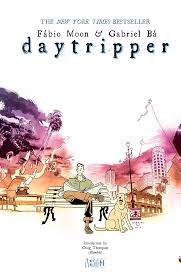
This is a deeply philosophical and meditative work about a man’s life, exploring the nature of love, loss, and the choices that shape us. The non-linear storytelling, paired with evocative art, builds a narrative about the fleeting nature of existence. It’s one of the most introspective graphic novels, asking the big questions about life and what it means to truly live.
Daytripper by Fábio Moon and Gabriel Bá is a graphic novel that explores the many possible lives—and deaths—of Brás de Oliva Domingos, an aspiring writer living in Brazil. Each chapter shows a different version of Brás’s life, ending with his unexpected death at various ages and stages: as a child, a lover, a father, a successful author, or someone still chasing his dreams.
These alternate timelines reveal how small choices and random moments can define a life. Brás grapples with questions of purpose, family, love, and legacy, especially in the shadow of his famous novelist father. As he lives and dies in different ways, the story emphasizes the fragility of life and the beauty in everyday moments.
The shifting timelines create a meditation on how death gives meaning to life. Despite the tragic structure, the story is ultimately hopeful and tender. Its emotional weight comes from its focus on relationships, regrets, and the moments that matter most. Daytripper reminds readers that every day is a chance to live fully, no matter how it ends.
- Blankets by Craig Thompson

Blankets by Craig Thompson is a deeply personal graphic memoir that falls within the coming-of-age and autobiographical genres. It tells the story of Craig’s childhood and adolescence in a strict Christian household, focusing on his first love, family relationships, and his spiritual journey.
The memoir blends lyrical storytelling with expressive, detailed artwork to explore themes of faith, identity, love, and loss. Through intimate reflections and vivid memories, Blankets captures the emotional complexities of growing up, questioning belief, and the painful process of self-discovery. Its genre combination makes it a poignant and universal tale about youth, vulnerability, and the search for meaning.
Blankets, is a coming-of-age story that explores family, faith, and first love. Thompson’s delicate and expressive art beautifully complements the emotional intensity of the narrative, which touches on themes of adolescence, isolation, and spiritual awakening. The combination of visual beauty and emotional depth makes it a quintessential work in the literary graphic novel genre.
Blankets by Craig Thompson is a deeply personal graphic memoir that explores first love, family, faith, and self-discovery. The story follows Craig’s childhood in a conservative Christian household in rural Wisconsin, marked by sibling bonds, bullying, and a strict religious upbringing.
As a teenager, Craig falls in love with Raina, a kindred spirit he meets at a church camp, and they begin a tender, intense relationship. He visits her over a winter break, experiencing both emotional closeness and the cracks in her own troubled family life. Through this relationship, Craig begins to question his religious beliefs and the limitations of his upbringing.
The warmth and intimacy of their connection contrast with the confusion and pain of growing up. After their relationship ends, Craig is left to navigate the loss, re-evaluate his faith, and come to terms with his identity as an artist. Told with expressive, sweeping artwork, Blankets captures the ache of adolescence, the search for meaning, and the bittersweet nature of memory. It is a poignant coming-of-age story about love, loss, and letting go.
- I Kill Giants by Joe Kelly and J.M. Ken Niimura
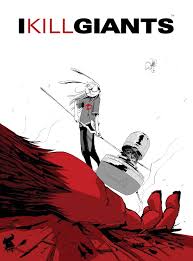
I Kill Giants by Joe Kelly and J.M. Ken Niimura is a graphic novel that blends fantasy, coming-of-age, and psychological drama genres. The story centers on Barbara Thorson, a young girl who escapes into a vivid fantasy world where she battles giants threatening her town. This imaginative quest serves as a metaphor for her real-life struggles with grief, trauma, and emotional pain, particularly related to her mother’s illness.
Combining elements of magical realism with raw emotional depth, I Kill Giants explores themes of mental health, denial, courage, and resilience. Its genre mix creates a powerful narrative about facing fears, accepting reality, and finding strength in vulnerability.
This story centers around a young girl named Barbara who escapes into a fantasy world where she battles giants. It’s a deeply emotional narrative about loss, grief, and coping with difficult realities. The combination of the fantasy setting with very real psychological struggles creates a heartbreaking and insightful story about the power of imagination and resilience.
I Kill Giants by Joe Kelly and J.M. Ken Niimura is a powerful graphic novel about Barbara Thorson, a fiercely imaginative and troubled young girl who believes she must protect her town from deadly giants. Armed with a mythical warhammer named Coveleski, Barbara escapes into a fantasy world to cope with a painful reality her mother’s terminal illness. At school, she struggles with bullies, isolation, and therapy, pushing away those who try to help, including a kind new friend, Sophia.
As the line between fantasy and reality blurs, Barbara’s giant-hunting becomes a metaphor for her emotional battle. Her fears and denial build toward a dramatic confrontation with a towering giant, forcing her to face the truth she’s been avoiding. The story reveals that the true monster is grief, and Barbara must accept her mother’s fate to move forward. Through stunning visuals and heartfelt storytelling, I Kill Giants explores mental health, trauma, and the power of imagination. It’s a coming-of-age tale about courage, loss, and healing. The novel delivers a moving message: facing your fears is the bravest act of all. A must-read graphic novel for fans of emotional, fantasy-driven stories about childhood and resilience.
- The Color of Earth Trilogy by Kim Dong Hwa
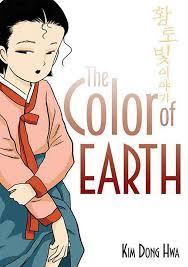
The Color of Earth trilogy by Kim Dong Hwa is a coming-of-age graphic novel series rooted in the genres of memoir, slice-of-life, and historical fiction. It beautifully captures the emotional growth and self-discovery of Ehwa, a young girl growing up in rural Korea.
Blending poetic storytelling with delicate watercolor art, the trilogy explores themes of family bonds, womanhood, love, and identity within the context of traditional Korean culture. Through intimate mother-daughter conversations and vivid depictions of nature, the series offers a tender, reflective look at adolescence, cultural expectations, and the transition from childhood to adulthood. Its genre mix makes it a heartfelt exploration of personal and cultural transformation.
This Korean coming-of-age trilogy explores the life of a young girl, her relationship with her mother, and her evolving understanding of love and adulthood. The delicate art and poignant, tender storytelling address universal themes of growing up, loss, and the cycles of life.
It’s a quiet, introspective work that resonates deeply. The Color of Earth trilogy by Kim Dong Hwa is a beautifully illustrated coming-of-age graphic novel series that follows a young Korean girl named Ehwa as she grows up in a rural village with her widowed mother.
The series—The Color of Earth, The Color of Water, and The Color of Heaven—traces Ehwa’s journey from childhood to womanhood, exploring her awakening to love, desire, and independence. Through conversations with her mother, who runs a tavern, Ehwa learns about womanhood, relationships, and the complexities of romantic longing. Her mother’s quiet yearning for a traveling salesman mirrors Ehwa’s own emotional growth as she falls in love with a young monk.
Set in a traditional, conservative Korean society, the trilogy uses nature imagery and poetic language to express intimate, emotional experiences. The bond between mother and daughter forms the emotional heart of the series, as they both navigate love, loneliness, and societal expectations. As Ehwa matures, she gains confidence and agency over her body and choices. The series is a lyrical meditation on femininity, identity, and the beauty of emotional vulnerability. The Color of Earth trilogy is a tender and empowering story of love, loss, and self-discovery.
- The Walking Dead by Robert Kirkman
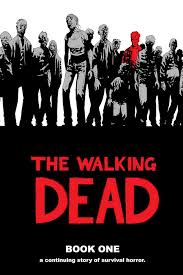
The Walking Dead graphic novel series falls primarily within the horror and post-apocalyptic genres. It combines intense zombie horror with a gritty survival drama, exploring how humanity endures when society collapses under the threat of the undead. Beyond just monster scares, it delves deeply into psychological horror, moral ambiguity, and the dark complexities of human nature in extreme circumstances.
The series also fits into the thriller and dystopian categories, as it portrays a brutal world where trust is scarce, and characters must navigate constant danger from both zombies and other survivors. Its genre blend makes it a powerful exploration of survival, community, and the fight to retain humanity in a world overrun by chaos.
Although The Walking Dead is often seen as a genre comic, it transcends the zombie apocalypse genre by exploring deeply human themes like survival, leadership, morality, and the breakdown of society. Kirkman’s exploration of character relationships and social dynamics, alongside the bleak artwork, make this series both a literary and philosophical meditation.
The Walking Dead by Robert Kirkman and Tony Moore (later illustrated by Charlie Adlard) is a gritty, post-apocalyptic graphic novel series that follows Rick Grimes, a sheriff’s deputy who wakes from a coma to find the world overrun by zombies—called “walkers.” As Rick searches for his family, he encounters other survivors struggling to stay alive amid constant threats from both the undead and other desperate humans. The series explores themes of survival, morality, leadership, and the breakdown of society.
Rick becomes the leader of a group trying to rebuild some semblance of community in a chaotic world. Throughout the series, the survivors face brutal challenges, including scarce resources, internal conflicts, and violent enemies. Relationships are tested as characters confront loss, trauma, and their own humanity.
The series is known for its intense, emotional storytelling and complex characters who evolve in response to harsh realities. The Walking Dead combines horror with deep explorations of what it means to survive and retain hope in a shattered world. It’s a landmark zombie apocalypse story that has spawned TV adaptations and a massive fanbase.




